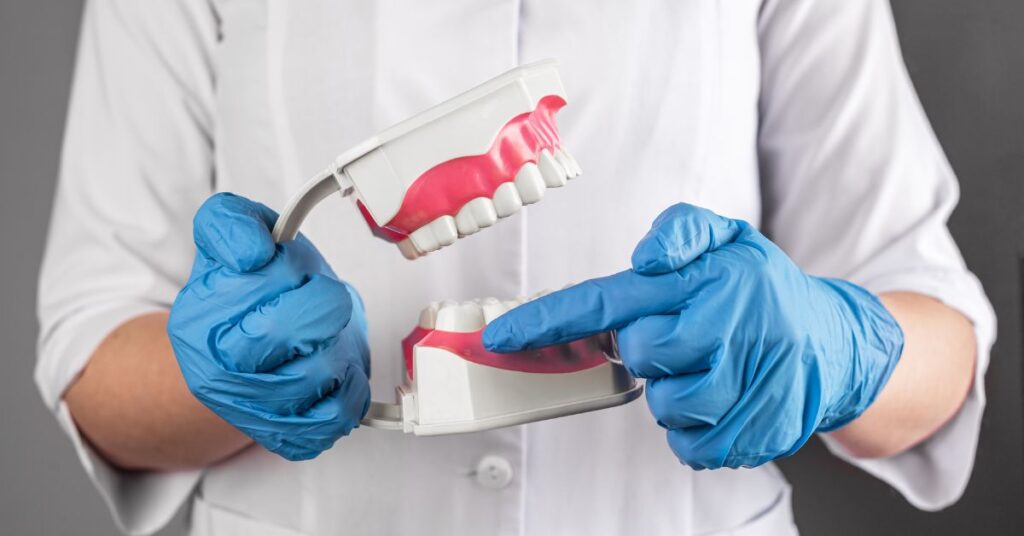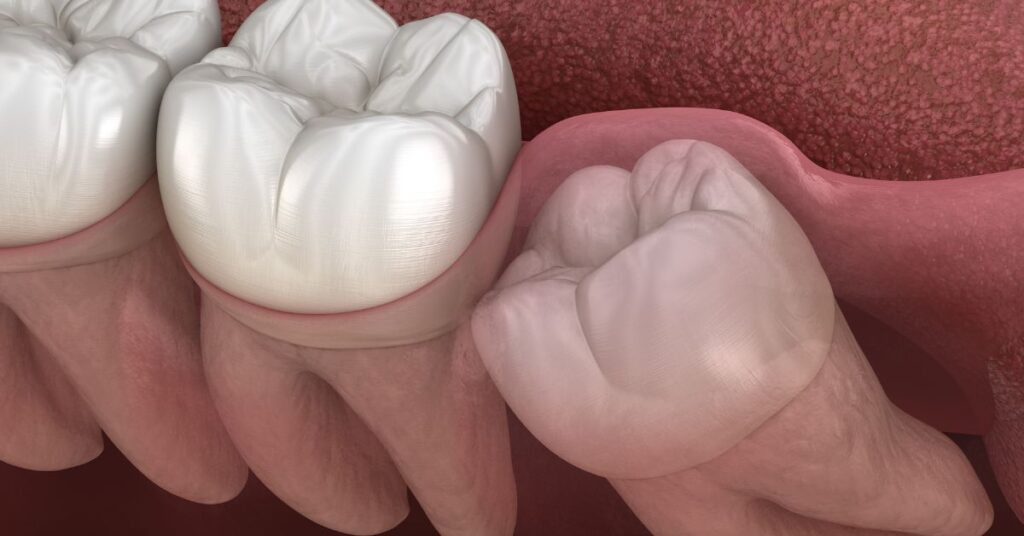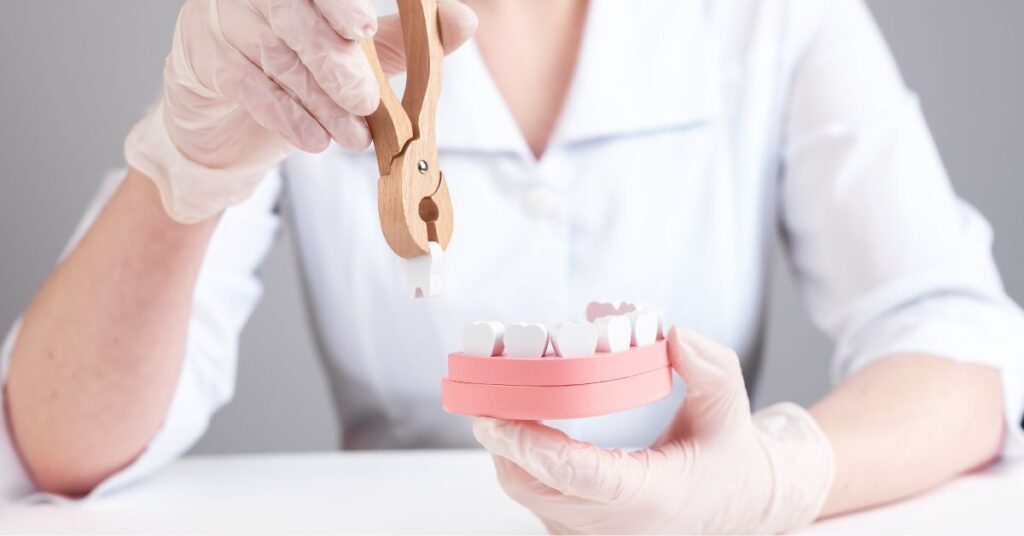
Introduction
Wisdom teeth, also known as third molars, are the rearmost teeth in your mouth, typically emerging during late adolescence or early adulthood. For many, they are a source of curiosity and concern. In this introductory chapter, we’ll delve into the world of wisdom teeth, exploring what they are, their common characteristics, and the reasons why understanding them is essential. Let’s embark on this journey to navigate the complex realm of wisdom teeth.
What Are Wisdom Teeth?
Wisdom teeth, scientifically known as third molars, are the last set of molars located at the back of your mouth. Most people develop four wisdom teeth, with one in each quadrant of the mouth. These teeth typically begin to emerge between the ages of 17 and 25, marking the transition from adolescence to adulthood. While they are called “wisdom teeth,” their emergence isn’t necessarily related to gaining wisdom. Instead, it’s a term rooted in historical tradition.
The Common Wisdom Teeth Experience
Understanding the common wisdom teeth experience is essential. Many people will undergo the development and emergence of these teeth, and it can be a significant event in one’s oral health journey. Wisdom teeth have been a part of human evolution, but their relevance in the modern world is more complex. Exploring the journey many individuals go through with their wisdom teeth can help demystify this process.
The Importance of Understanding Wisdom Teeth
Why should you care about wisdom teeth? These teeth often become a topic of discussion in dental care, as they can bring both benefits and challenges. Recognizing the significance of understanding wisdom teeth is crucial for informed decision-making about their management and potential removal. We will explore the roles, potential issues, and factors that contribute to the importance of wisdom teeth.
Navigating the Journey of Wisdom Teeth Removal
For many, wisdom teeth removal becomes a necessary step in their oral health journey. This chapter will set the stage for discussions on the removal process, indications for extraction, and the different aspects involved in the journey of wisdom teeth removal. As we move forward in this guide, you’ll gain insights into the complexities and considerations surrounding wisdom teeth.
Let’s begin this exploration of wisdom teeth, shedding light on these intriguing latecomers in the world of dentition.
The Anatomy of Wisdom Teeth

In our exploration of wisdom teeth, it’s essential to understand their anatomy. These enigmatic third molars have a fascinating history and serve as a reminder of our evolutionary past. In this chapter, we delve into the origins of wisdom teeth, the different types that exist, and their role in our evolutionary lineage. We also examine their significance in our modern world.
Origins of Wisdom Teeth
Wisdom teeth, or third molars, have an evolutionary tale to tell. They trace back to our distant ancestors who needed these additional molars for grinding and processing a coarse diet. Over time, our diets and eating habits have evolved, but these molars remain as remnants of our evolutionary heritage. Understanding their origins provides insight into their existence.
Types of Wisdom Teeth
Not all wisdom teeth are created equal. While most people develop four of these molars, there can be variations in their number and formation. Some individuals may have fewer or more wisdom teeth than the typical four. These variations can influence the overall dental structure and the experiences people have with their wisdom teeth.
The Role of Wisdom Teeth in Evolution
As we delve into the fascinating world of wisdom teeth, it’s vital to explore their role in the evolutionary development of our species. These molars once played a critical part in our ancestors’ survival, enabling them to chew fibrous and tough foods. This chapter uncovers the evolutionary significance of wisdom teeth and how their presence reflects our ancient dietary needs.
Modern Implications of Wisdom Teeth
While wisdom teeth were once vital for our ancestors, their role in the modern world is different. With changes in our diet, jaw size, and dental care practices, the significance of these molars has evolved. Today, wisdom teeth often bring more challenges than benefits, raising questions about their necessity in contemporary dentistry.
Join us in the next chapter as we explore the theoretical functions of wisdom teeth and their relevance in modern times.
The Truth About Wisdom Teeth Pain

While wisdom teeth have sparked curiosity and debate over their purpose, one undeniable reality is that they can bring discomfort and pain to many. In this chapter, we’ll explore the common causes of wisdom teeth pain, why these molars can become problematic, and the available options for managing and mitigating this discomfort.
Common Causes of Wisdom Teeth Pain
Misalignment and Impaction
One of the primary reasons for wisdom teeth pain is misalignment and impaction. These molars often struggle to find adequate space in the jaw, leading to various degrees of impaction. When a wisdom tooth doesn’t emerge correctly, it can become trapped beneath the gum line or adjacent teeth. This misalignment can result in pain, pressure, and discomfort.
Gum Inflammation and Infection
The emergence of wisdom teeth can sometimes lead to gum issues. As they push through the gum tissue, it may become inflamed or infected. This inflammation can cause pain, swelling, and redness in the area surrounding the emerging tooth.
Crowding
Wisdom teeth often arrive when the jaw is already filled with other permanent teeth. Their appearance can lead to crowding, where existing teeth are pushed or rotated out of alignment. This can cause pain as teeth are forced into positions they aren’t naturally meant to occupy.
Why Wisdom Teeth Can Be Problematic
Difficulty in Cleaning
The location of wisdom teeth at the back of the mouth makes them challenging to clean properly. As a result, they are more susceptible to decay and gum disease, which can cause pain and other oral health issues.
Jaw Pain
The pressure from emerging or impacted wisdom teeth can lead to jaw pain, which can radiate throughout the face and head. This pain can vary from mild discomfort to severe, debilitating pain.
Bite Irregularities
The appearance of wisdom teeth can disrupt your bite, causing an uneven distribution of force when you chew. This can lead to pain in the jaw joints, known as temporomandibular joints, or TMJ.
Understanding the Pain Management Options
Dealing with wisdom teeth pain requires proper management. Whether your wisdom teeth have emerged and are causing discomfort or they remain beneath the surface, you have options to address the pain:
Over-the-Counter Pain Relievers
For mild to moderate pain, over-the-counter pain relievers like ibuprofen can provide relief. They help reduce inflammation and alleviate discomfort.
Prescription Medications
In cases of severe pain or post-surgical discomfort following wisdom teeth removal, your dentist or oral surgeon may prescribe stronger pain medications.
Home Remedies
Home remedies like warm salt water rinses and cold compresses can help reduce inflammation and ease pain.
Wisdom Teeth Removal
For persistent or severe pain associated with wisdom teeth, removal may be recommended. This surgical procedure eliminates the source of discomfort and prevents future issues.
In the upcoming chapter, we’ll delve into the timing of wisdom teeth emergence, discussing when these molars typically make their appearance, variations in development, and the importance of early detection.
The Timing of Wisdom Teeth Emergence

The arrival of wisdom teeth is a natural part of human development, but it can be a source of curiosity and concern. In this chapter, we’ll delve into the timing of wisdom teeth emergence, discuss when these molars typically make their appearance, explore variations in development, and emphasize the importance of early detection.
When Wisdom Teeth Typically Emerge
Late Adolescence to Early Adulthood
Wisdom teeth, also known as third molars, typically emerge during the late teens to early twenties. These years mark the age when individuals gain wisdom teeth, although the timing can vary from person to person.
Fully Developed Permanent Dentition
Wisdom teeth come after the full development of permanent dentition, which means all the other permanent teeth are already in place. Their emergence is essentially a late addition to your adult set of teeth.
Oral Examination and X-rays
Regular oral check-ups and X-rays play a crucial role in monitoring the emergence of wisdom teeth. Dentists can determine the stage of development and alignment of these molars through these diagnostic tools.
Variations in Wisdom Teeth Development
Early Emergence
In some cases, wisdom teeth may emerge as early as the late teens, while other people may not see them until their mid-twenties. Early emergence might not be problematic if the molars align correctly with the existing teeth and do not lead to discomfort or complications.
Delayed Emergence
On the other hand, wisdom teeth can take longer to appear. Delayed emergence might not cause concern as long as there are no symptoms of impaction, pain, or crowding.
Unusual Number of Wisdom Teeth
While most individuals have four wisdom teeth, some may develop fewer, known as hypodontia, or extra molars, a condition called hypodontia. Unusual numbers of wisdom teeth can create unique dental challenges.
Signs of Wisdom Teeth Emergence
Discomfort or Pain
One of the most common signs of wisdom teeth emergence is discomfort or pain in the back of the mouth. This pain can be intermittent and may worsen during the eruption process.
Swelling and Redness
As the wisdom teeth push through the gums, you might notice localized swelling and redness. This is a common sign that the molars are on their way.
Difficulty in Opening the Mouth
In some cases, wisdom teeth can cause limited mouth opening due to the pressure they exert during their emergence.
The Importance of Early Detection
Early detection of wisdom teeth emergence is essential for timely intervention and management. Regular dental check-ups and X-rays can help identify the position and alignment of these molars before complications arise. Addressing any issues promptly can prevent pain, infection, and other oral health problems.
In the next chapter, we will explore the complications that can arise when wisdom teeth do not emerge properly, including impacted wisdom teeth, infections, and cysts.
Wisdom Teeth Complications

Wisdom teeth are enigmatic, often causing more complications than comfort. In this chapter, we will unravel the intricacies of wisdom teeth complications, including the woes of impacted molars, the risk of infections and cysts, the unsettling issues of crowding and displacement, and other dental problems associated with these late-blooming molars.
Impacted Wisdom Teeth
Misaligned Growth
Impaction occurs when wisdom teeth don’t emerge properly due to misalignment. These molars can grow at various angles, including horizontally, vertically, or even diagonally.
Signs of Impaction
Signs of impacted wisdom teeth may include pain or discomfort in the back of the mouth, swelling, redness, and even bad breath due to bacterial buildup around the partially emerged teeth.
Potential Complications
If left untreated, impacted wisdom teeth can lead to more severe problems, such as gum disease, dental cysts, and the resorption of neighbouring teeth.
Infections and Cysts
Bacterial Invasion
Partially emerged wisdom teeth can create a nook where bacteria thrive, leading to infections. Infections around wisdom teeth are not only painful but can also spread to other parts of the mouth.
Development of Cysts
Cysts can form around impacted wisdom teeth. These fluid-filled sacs can damage the jawbone and surrounding teeth if left unattended. Cysts may also be asymptomatic, making regular dental check-ups essential.
Crowding and Displacement
Crowding Issues
Wisdom teeth can cause crowding when they push against the existing teeth, disrupting their alignment. This can lead to a need for orthodontic treatment to correct the misalignment.
Displacement of Other Teeth
In some cases, wisdom teeth can displace neighbouring molars, causing not only discomfort but also impacting the functionality of adjacent teeth.
Other Dental Issues Associated with Wisdom Teeth
Damage to Adjacent Teeth
Impacted wisdom teeth can exert pressure on the adjacent molars, causing them to weaken or crack.
Periodontal Problems
The presence of impacted wisdom teeth can increase the risk of periodontal disease, as cleaning and flossing around these molars is challenging.
The impact of these complications can vary from person to person, and not everyone with wisdom teeth experiences these issues. Nevertheless, understanding the potential complications is essential for making informed decisions about whether to retain or remove these molars.
In the next chapter, we will explore the reality of wisdom teeth removal, including the indications, preparation, the procedure itself, and what to expect during the recovery and aftercare process.
Wisdom Teeth Removal: The Reality

Wisdom teeth removal is a significant dental procedure that many individuals face. In this chapter, we delve into the realities of this process, examining the indications for removal, what it involves, and what to expect during and after the procedure.
Indications for Wisdom Teeth Removal
Crowding
One common reason for wisdom teeth removal is dental crowding. These late-blooming molars often disrupt the alignment of existing teeth, causing them to shift or become misaligned.
Impaction
Impacted wisdom teeth, which don’t emerge properly, can lead to pain, infections, cysts, or other complications, making removal necessary.
Tooth Decay and Gum Disease
Wisdom teeth are located at the back of the mouth, making them challenging to clean properly. This can lead to tooth decay and an increased risk of gum disease, which may necessitate removal.
Orthodontic Treatment
In some cases, wisdom teeth must be removed to facilitate orthodontic treatment or to protect the results of prior orthodontic work.
Preparing for Wisdom Teeth Extraction
Dental Examination
Before the procedure, your dentist will conduct a thorough examination, often including X-rays, to determine the position and condition of your wisdom teeth.
Anesthesia
Most wisdom teeth extractions are performed under local anaesthesia to numb the area. However, some cases may require general anaesthesia, especially if all four wisdom teeth are removed at once.
Preoperative Instructions
Your dentist will provide you with preoperative instructions, which may include fasting for a certain period before the procedure.
What to Expect During the Procedure
Incision and Tooth Division
The dentist will make an incision in the gum tissue, expose the tooth, and may divide it into smaller sections for easier removal.
Extraction
Using specialized tools, the dentist carefully extracts the wisdom tooth. Patients usually feel pressure but not pain during this phase due to the anaesthesia.
Recovery and Aftercare
Postoperative Care
After the procedure, you will receive postoperative care instructions, including advice on managing swelling, bleeding, and discomfort.
Diet and Oral Hygiene
You may need to follow a soft diet for a few days and practice gentle oral hygiene to prevent infection and promote healing.
Follow-Up Appointments
It’s essential to attend any follow-up appointments with your dentist to ensure proper healing and address any concerns.
Wisdom teeth removal is a common dental practice aimed at preventing complications and maintaining your oral health. In the next chapter, we’ll address the prevalent myths associated with wisdom teeth and debunk them with evidence-based information.
Conclusion
As we conclude our journey through the intriguing world of wisdom teeth, it’s important to recap the key insights and considerations.
The Complex Reality of Wisdom Teeth
Wisdom teeth, or third molars, have a complex history and role in human oral health. While they may have been beneficial for our ancestors with different diets, the modern world presents challenges. These teeth often lack the necessary space in our jaws and can lead to various dental complications.
Making Informed Decisions About Wisdom Teeth
Decisions regarding wisdom teeth should be well-informed. It’s essential to consider factors such as their development, the presence of symptoms, and your overall dental health. Your dentist or oral surgeon can provide expert guidance on whether removal is necessary.
Your Wisdom Teeth Journey Awaits
The journey of managing wisdom teeth is a unique experience for each individual. Some may go through life without any issues, while others might encounter complications that require intervention. Regular dental check-ups and open communication with your oral healthcare provider are key to ensuring the best possible outcome.
In this comprehensive guide, we’ve navigated through the origins, purposes, challenges, and management of wisdom teeth. We’ve addressed common myths and explored alternative solutions. Now, equipped with knowledge and understanding, you’re better prepared to make decisions about your own wisdom teeth.
The journey may be uncertain, but with the right information and support, you can ensure your oral health is in the best possible hands. Whether you’re taking a proactive approach to removal or adopting a watchful waiting strategy, the wisdom teeth journey is yours to navigate.
Thank you for joining us on this exploration of wisdom teeth. We wish you the best of dental health on your unique journey.
